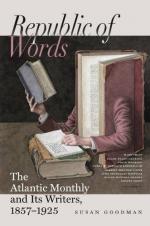wares. And blent with this pervading language
of colors are the local associations which the articles
of merchandise hint. Consider how extensive is
their scope,—Persian carpets, Lyons silks,
Genoa velvets, ribbons from Coventry and laces from
Brussels, the furs of the Northwest, glass of Bohemia,
ware of China, nuts from Brazil, silver of Nevada
mines, Sicily lemons, Turkey figs, metallic coffins
and fresh violets, Arabian dates, French chocolate,
pine-apples from the West Indies, venison from the
Adirondacs, brilliant chemicals, gilded frames, Manchester
cloth, Sheffield cutlery, Irish linens, ruddy fruit,
salmon from the Thousand Isles, sables from Russia,
watches from Geneva, carvings from Switzerland, caricatures
and India-rubber garments, saccharine temples, books
in tinted covers, toys, wines, perfumes, drugs, dainties,
art, luxury, science, all lavishing their products
to allure the throng,—phenomena common,
indeed, to all streets devoted to trade, but here
uniquely combined with a fashionable promenade, and
affording the still-life of a variegated moving panorama.
It is characteristic, also, that the only palatial
buildings along the crowded avenue are stores and
hotels. Architecture thus glorifies the gregarious
extravagance of the people. The effect of the
whole is indefinitely prolonged, to an imaginative
mind, by the vistas at the lower extremity, which
reveal the river, and, at sunset, the dark tracery
of the shipping against the far and flushed horizon;
while, if one lifts his eye to the telegraph wire,
or lowers it to some excavation which betrays the
Croton pipes, a sublime consciousness is awakened of
the relation of this swift and populous eddy of life’s
great ocean to its distant rural streams, and the
ebb and flow of humanity’s eternal tide.
Consider, too, the representative economics and delectations
around, available to taste, necessity, and cash,—how
wonderful their contrast! Not long since, an
Egyptian museum, with relics dating from the Pharaohs,
was accessible to the Broadway philosopher, and a
Turkish khan to the sybarite; one has but to mount
a staircase, and find himself in the presence of authentic
effigies of all the prominent men of the nation, sun-painted
for the million. This pharmacist will exorcise
his pain-demon; that electrician place him en rapport
with kindred hundreds of miles away, or fortify his
jaded nerves. Down this street he may enjoy a
Russian or Turkish bath; down that, a water-cure.
Here, with skill undreamed of by civilized antiquity,
fine gold can be made to replace the decayed segment
of a tooth; there, he has but to stretch out his foot,
and a chiropodist removes the throbbing bunion, or
a boy kneels to polish his boots. A hackman is
at hand to drive him to the Park, a telescope to show
him the stars; he has but to pause at a corner and
buy a journal which will place him au courant
with the events of the world, or listen to an organ-grinder,
and think himself at the opera. This temple is




